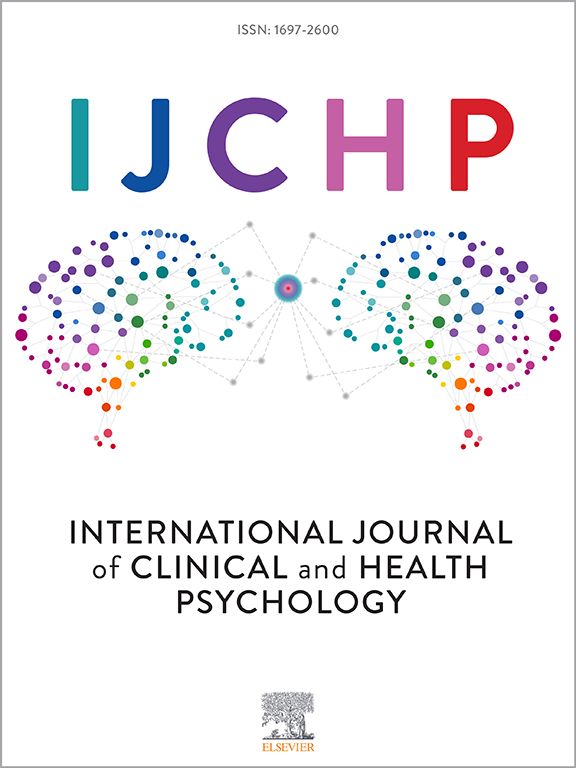Modulating prefrontal cortex activity to alleviate stress-induced working memory deficits: A transcranial direct current (tDCS) study
IF 4.4
1区 心理学
Q1 PSYCHOLOGY, CLINICAL
International Journal of Clinical and Health Psychology
Pub Date : 2025-04-01
DOI:10.1016/j.ijchp.2025.100569
引用次数: 0
Abstract
This study explores the impact of stress on working memory (WM) performance, and the potential mitigating effects of transcranial direct current stimulation (tDCS) over the left dorsolateral prefrontal cortex (dlPFC) and ventromedial prefrontal cortex (vmPFC). The study had a mixed, randomized, single-blind, sham-controlled design, with stress induction as within-subject and stimulation condition as between-subject factors. We assessed stress-induced WM deficits using aversive video clips to induce stress and a verbal n-back task to assess WM performance. We analyzed physiological (cortisol and heart rate), behavioral, and electroencephalographic (EEG) changes due to stress before, during, and after WM task performance and their modulation by tDCS. Stress impaired WM performance in the sham stimulation condition for the 3-back load, but not for 2-back or 4-back loads in the WM task and was associated with elevated physiological stress markers. tDCS over the vmPFC led to better WM task performance while stimulation over the dlPFC did not. Active tDCS with both dlPFC and vmPFC stimulation blunted cortisol release in stress conditions compared to sham. The EEG analysis revealed potential mechanisms explaining the behavioral effects of vmPFC stimulation. vmPFC stimulation led to a decreased P200 event-related potential (ERP) component compared to the sham stimulation condition and resulted in higher task-related alpha desynchronization, indicating reduced distractions and better focus during task performance. This study thus shows that the vmPFC might be a potential target for mitigating the effects of stress on WM performance and contributes to the development of targeted interventions for stress-related cognitive impairments.
调节前额叶皮层活动减轻应激性工作记忆缺陷:经颅直流电(tDCS)研究
本研究探讨应激对工作记忆(WM)表现的影响,以及经颅直流电刺激(tDCS)对左背外侧前额叶皮层(dlPFC)和腹内侧前额叶皮层(vmPFC)的潜在缓解作用。该研究采用混合、随机、单盲、假对照设计,应激诱导为受试者内部因素,刺激条件为受试者之间因素。我们使用令人厌恶的视频片段来诱导压力,并使用口头n-back任务来评估WM表现,以此来评估压力诱导的WM缺陷。我们分析了在WM任务执行之前、期间和之后由于应激引起的生理(皮质醇和心率)、行为和脑电图(EEG)变化以及tDCS对它们的调节。在3背负荷的假刺激条件下,应激损害了WM任务的表现,但在2背或4背负荷的WM任务中,应激没有损害WM任务的表现,并且与生理应激标志物升高有关。vmPFC上的tDCS导致更好的WM任务表现,而dlPFC上的刺激则没有。与假手术相比,激活tDCS同时刺激dlPFC和vmPFC使应激条件下的皮质醇释放减弱。脑电图分析揭示了解释vmPFC刺激行为影响的潜在机制。与假刺激相比,vmPFC刺激导致P200事件相关电位(ERP)成分下降,导致更高的任务相关α去同步,表明在任务执行过程中分心减少,注意力更好。因此,本研究表明vmPFC可能是减轻压力对WM表现影响的潜在靶点,并有助于开发针对压力相关认知障碍的针对性干预措施。
本文章由计算机程序翻译,如有差异,请以英文原文为准。
求助全文
约1分钟内获得全文
求助全文
来源期刊

International Journal of Clinical and Health Psychology
PSYCHOLOGY, CLINICAL-
CiteScore
10.70
自引率
5.70%
发文量
38
审稿时长
33 days
期刊介绍:
The International Journal of Clinical and Health Psychology is dedicated to publishing manuscripts with a strong emphasis on both basic and applied research, encompassing experimental, clinical, and theoretical contributions that advance the fields of Clinical and Health Psychology. With a focus on four core domains—clinical psychology and psychotherapy, psychopathology, health psychology, and clinical neurosciences—the IJCHP seeks to provide a comprehensive platform for scholarly discourse and innovation. The journal accepts Original Articles (empirical studies) and Review Articles. Manuscripts submitted to IJCHP should be original and not previously published or under consideration elsewhere. All signing authors must unanimously agree on the submitted version of the manuscript. By submitting their work, authors agree to transfer their copyrights to the Journal for the duration of the editorial process.
 求助内容:
求助内容: 应助结果提醒方式:
应助结果提醒方式:


